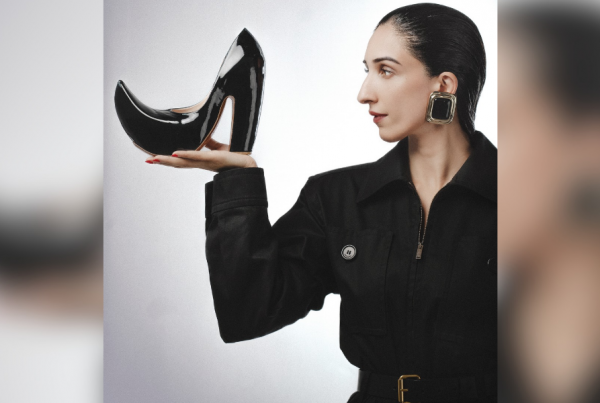One of the most successful films of this year opens to this scenario: Jawed Sheikh is on his way to visit an old childhood friend in order to meet his potential daughter-in-law. His friend’s driver receives the family at the airport and keeps talking about how beautiful, smart and elegant the bride-to-be is on their ride home. However, an overweight, thus unattractive woman enters the room to serve tea and Sheikh, and his seemingly handsome son Danish Taimoor are shocked, rather revolted. But it’s all in good fun because soon, the slim and beautiful Sana Javed enters the room, and everyone realizes that they were simply looking at the wrong girl. Sheikh, and everyone else in the room, has a good laugh at how hilarious it is to even think that this overweight girl could be their bahu.

The aforementioned scene takes place in Sana Javed and Danish Taimoor’s latest film, Mehrunisa V Lub U.
Here’s another instance where one must have seen an overweight girl on television. A popular game show has a segment in which the host invites overweight people on stage and makes them stand on the weighing machine. The heaviest person wins. Sometimes the host can be seen scratching his head in bewilderment, wondering how somebody could be so fat.
Ladies and gentlemen, it’s 2017 and the only time one will see overweight people on the big screen in Pakistan is when the person in question is the butt of the joke and is simply there for comic relief.
The scenario in Pakistan is so bad that pregnant women aren’t allowed to be fat; they are definitely not allowed to be fat once they deliver their baby. If six months after their baby has been delivered and they’re still not looking like a size zero model, then in comes the haw-haye brigade, fat shaming women to no end. Case in point, Sanam Jung has been fat shamed mercilessly for putting on weight after her pregnancy and not losing it all fast enough.
If one is still unsure about how body positivity is a progressive and pertinent movement, let us introduce you to how the rest of the world has embraced it.
Catching up with global trends
Unlike what many people believe, Body Positivity is a movement that suggests that all kind of bodies deserve to be accepted and loved. There is a misconception that body positivism is only restricted to plus size women. Actually the movement tries to include race, skin colour, weight, height and every other quality that could set one’s body apart. The idea is to break the stereotyped image of what a beautiful person is supposed to look like: young, fair, slender, and tall with flawless skin.
For instance, model Winnie Harlow is a good example to start with. Harlow was discovered by Tyra Banks on the twenty-first cycle of the reality show, America’s Next Top Model and she stood out from the rest because of her skin condition, vitiligo. Currently, Harlow has appeared in Glamour, Vogue Italia and Cosmopolitan and has featured in campaigns for big brands like Diesel and Swarovski. She’s also an activist and is vocal about vitiligo; she also spends a lot of time encouraging others to develop their self-esteem despite of what their body looks like.

Winnie Harlow was first discovered by Tyra Banks on the twenty-first cycle of the reality show, America’s Next Top Model and she stood out because of her skin condition, vitiligo.
Ashley Graham is another prominent name working to promote body positivity. She was the first plus-sized supermodel to appear on the cover of Sports Illustrated, which has previously featured the likes of Chrissy Teigen, Kate Upton and Irina Shayk. Graham also made history by being the first plus sized model to walk for Michael Kors at New York Fashion Week 2017. Another first in this supermodel’s list is the Vogue cover, making her the first supermodel to land the coveted spot.
And there are countless other examples to take inspiration from. Currently, many major beauty campaigns make sure to create body positive imagery. For instance, Dove’s Real Beauty campaign showcased the portraits of 32 women from the ages of 11 till 71, from 15 different countries around the world, such as Brazil, China, India and the Philippines.
Nike also showcased a body positive campaign for plus size women last year and finally decided to launch its first ever plus size range for women.
Perhaps this is where majority of the problem lies when it comes to embracing bigger, fuller bodies. We assume that fat women simply don’t exercise or that fat equals to unhealthy and that may not necessarily be the case. Since every human body responds differently to exercise and diet, not every woman can look like Gigi Hadid no matter how hard they try. Hadid has genetically been born with a body type that is popular in mainstream media, which makes her the top choice for any designer, brand or label. You could work out six days a week and still appear chubby or ‘fat’. Therefore the notion that “fat equals unhealthy†is simply not true.
Talking about plus size in Pakistan
In Pakistan, body positivity is such an abstract concept that we haven’t even begun to accept overweight bodies, let alone be open to people with visible disabilities. While skin colour is still debated upon, thanks to models like Amna Ilyas who are vocal about the difficulties they face due to their skin colour, there is still no dialogue around plus size women.
According to Pakistan’s entertainment industry, plus size women are an exception, not the rule. Our TV screens rarely ever show women who aren’t thin. Our fashion industry also has the same problem. Runways are shining with (mostly) tall, slender and fabulous women who also appear in magazines, on billboards and an odd item number or two.
Rubya Chaudhry, a seasoned model who has been around long enough to know how the fashion industry works, spoke about the pressures on models and how they cope with it.
“There is an internalized standard which most models adhere to, even if nobody asks them to be thin. Some designers are vocal about it. For instance once a designer told me that it would be nice if I could lose some more weight and it was weird hearing that because at the time I was already quite thin. But most high end designers don’t make clothes for plus size women so a model who wasn’t thin wouldn’t get many work opportunities,†she confessed.

Rubya walks for Fnk Asia at Telenor Fashion Pakistan Week, 2015
One wonders if models ever resort to unhealthy behavior in order to maintain their physiques. “The fitness craze has recently taken up most people in Pakistan so it’s nice to see so many girls running off to the gym or taking yoga classes. I think the emphasis now is more on being fit as opposed to being thin so most models are going about everything the healthy way,†she observed.
Chaudhry tried to stress importance on what a huge impact self-image has on women as they are constantly comparing themselves to what’s considered beautiful. “The idea of a perfect body is just not realistic. Please don’t fall victim to people’s expectations of you. What truly matters is what you believe.â€
It seems as though many women in the media eventually do fall victim to society’s expectations after hearing countless taunts and reading a barrage of harsh comments on their social media accounts.
Currently, Hareem Farooq is one of the only body positive role models in Pakistani media as she is one of the few successful curvy women one gets to see in Pakistani films and TV dramas. She has recently been selected as the fitness mentor for Miss Veet 2017, an annual nationwide competition that has now evolved from a supermodel hunt to looking for an all rounder brand ambassador. Farooq has also gone on record to talk about how she was told that she was “too big or too fat to be in the media, especially in front of the camera.†Farooq took to her Instagram account and urged women to “Learn to love and accept yourself, we all have flaws learn to embrace them and make them you’re strength. Don’t let the society label you to their norms.â€

Hareem Farooq is one of the only body positive role models in Pakistani media as she is one of the few successful curvy women one gets to see in Pakistani films and TV dramas.
Ironically, one has noticed that Farooq seems to be shrinking by the day. The producer and actor has come a long way from her Janaan days and can be seen flaunting a much slimmer figure. While we’re all up for women to have the liberty to choose what they do with their bodies, it sends out a confusing message for young girls when their body positive role models start slimming down themselves.
And there many body positive women around the world who’ve done that. During the release of her film The Hunger Games, Jennifer Lawrence was very vocal about how Hollywood considered her a fat actress, which she absolutely was not even back then. She has continuously over the years spoken about how she would never slim down for a film and would never lose weight for Hollywood. However, over the years, one has seen Lawrence go down to a much smaller size. In fact, we first noticed her toned down body for her role as Mystique in the X-Men films. A superhero body is of course going to be lean and fit and Lawrence eventually succumbed to Hollywood’s expectations from her.

Jennifer Lawrence attends the 2016 Vanity Fair Oscar Party Hosted By Graydon Carter at the Wallis Annenberg Center for the Performing Arts on February 28, 2016 in Beverly Hills, California.
Another famous name for the body positive movement is singer Meghan Trainor who became instantly successful with her hit single, ‘All About That Bass’, a song that encouraged women to celebrate their curves and be happy with their fuller bodies. However, ever since the hit single, Trainor is rumoured to have lost nearly 25 – 30 pounds and is looking visibly slimmer than what she started out as. While it is entirely possible to love your body enough to want to exercise and get in shape, it makes for a confusing message to fans of these celebrities: does loving and accepting your body mean to lose weight and look slimmer?
Currently, it’s such a taboo to be ‘fat’ that even in the Qandeel Baloch biopic, Saba Qamar’s most obvious difference from the late Internet star was that Qamar was visibly much thinner than what Baloch used to be. We’ve seen the likes of Aamir Khan who’ve gained and reduced weight for their roles, such as the one in Dangal, or Bhumi Pedneker who gained nearly 30 kilos for her debut film, Dum Laga Ke Haisha and then shed all the weight off after the film. Is it perhaps too soon to expect that from our own actors? Or was there no other curvy actor available to play the role of Qandeel Baloch? Baloch’s weight was an important aspect of her personality because amid all the hate that came her way, she was constantly body-shamed by men and women alike.
Keeping in mind the fact that body positivity is a relatively new movement, it’s understandable that it will take time for it to reach Pakistan, because our audience is still learning to treat stars like normal, regular people. One tends to hold expectations from them which one wouldn’t hold for themselves. For instance, an overweight person or a dark person would still want to see a thin, fair model/actor on screen because it would just look better. It’s a complicated journey but it’s imperative that we take the first few steps towards it.
This article was originally published in Instep on Sunday, 30th July 2017.













